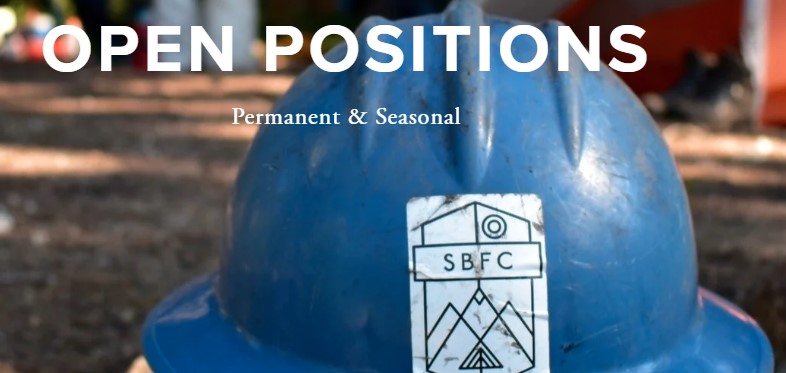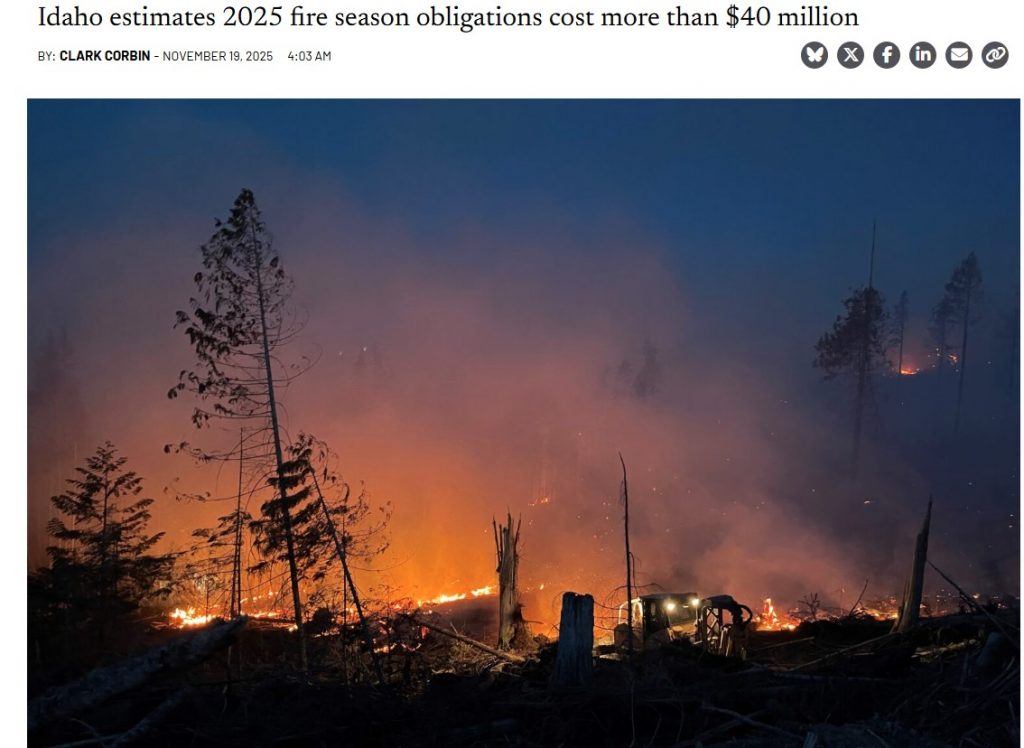Nearly two-thirds of Idaho land is public, which means that outdoor recreation is not just a huge economic driver, but, for a majority of Idahoans, it’s a way of life. Our public lands are managed by entities including the U.S. Forest Service (USFS), the Bureau of Land Management, Idaho Department of Lands, Idaho Fish and Game, and Idaho Department of Parks and Recreation. And behind the scenes, there are even more organizations working to keep these large acreages of land accessible to all of us. Here are just a few:
The Idaho Trails Association (ITA) was founded in 2010 and predominantly works on backcountry trails throughout Idaho. However, they’ve also recently expanded into the “front-country” of the Boise foothills and trails adjacent to cities including Pocatello, Sandpoint, and Coeur d’Alene.
In 2025, the ITA had over 800 volunteers with 15,000 hours of volunteer time on over 350 miles of trails. Volunteers don’t need to have prior experience — they receive training before starting projects. Projects range from easy to arduous and range in length from one day to over a week. Traditional tools including crosscut saws, axes, and Pulaskis are used for trail maintenance.
ITA partners with other trail groups to build capacity and work together to get more continuous miles of trail done, Executive Director Melanie Vining said. These include the Back Country Horsemen of Idaho, Great Burn Conservation Alliance, Ridge to Rivers, Friends of Scotchman Peaks Wilderness, and the Selway Bitterroot Frank Church Foundation (SBFC).
The SBFC was founded in 2006 by concerned citizens with help from the USFS to add capacity for on the ground stewardship in the Selway Bitterroot Wilderness. They added the Frank Church-River of No Return Wilderness to their work around 2012. Both wildernesses are managed by the USFS.
“Having a partner stewardship organization is critical for public lands management agencies, particularly when working in remote/large landscapes like the Selway and the Frank,” said Executive Director Ryan Ghelfi. With recent federal funding cuts, work from these partner organizations has become even more crucial. SBFC has continued to raise private funds to help augment the USFS capacity to get trail work and other stewardship projects done. They were even able to hire River Rangers and Checkers for the Middle Fork and Main Salmon Rivers.
The SBFC has engaged with approximately 200 volunteers this year, both adults and kids, who focused on trail maintenance which included removing downed logs, cutting back brush on trails, and rebuilding tread that had been washed away from time or extreme storms.
The Sawtooth Society was founded in 1997 by a group of landowners, politicians, and recreationalists to assist in preserving the scenic and historical values of the 756,000 acre Sawtooth National Recreation Area (SNRA).
They work with, but independent from, the USFS to assist in maintaining the 900 miles of trails, provide funding for improvement projects, and serve as a liaison for local, regional, and national collaboratives.
In a typical year, they facilitate around 700 hours of volunteer work alongside their paid staff. Volunteers complete a variety of tasks — from stuffing envelopes to bucking trees in the backcountry. With federal funding cuts, the SNRA had its staff dramatically reduced from 34 full-time, non-fire staff to just nine.
The Sawtooth Society was perfectly positioned to help in this situation with its own trail crew infrastructure. They additionally raised $80,000 from supporters to double their trail crew capacity and provide visitor services at the SNRA Headquarters.
“We were able to hire the crew the USFS would have hired, maintaining collective decades of SNRA trail knowledge that would have been lost otherwise. Most importantly, this ensured that trails that are used the most would be open and accessible for the many types of recreation that takes place in the SNRA,” Director of Operations Michael Hoover said.
The Central Idaho Mountain Bike Association (CIMBA) is based in the McCall area. With only two paid employees, the rest of the work is done by volunteers. CIMBA has helped to maintain mountain bike trails at places such as Ponderosa State Park, Brundage Mountain Resort, USFS land, and Jug Mountain Ranch. In the past, they have also partnered with the Central Idaho Trail Riders Alliance on projects. If you like to recreate — whether it’s motorcycles, mountain biking, hiking, or trail running, Trail Coordinator Jared Alexander stressed the importance of getting involved with your local volunteer groups.
Alexander also praised all of the people, or “trail fairies,” that aren’t even out with an organization who help clear trails on their own free time. All of us can be stewards of our public lands.
 https://idahocapitalsun.com/2025/11/19/balance-of-idahos-state-wildfire-suppression-fund-drops-to-15-million-after-2025-season/
https://idahocapitalsun.com/2025/11/19/balance-of-idahos-state-wildfire-suppression-fund-drops-to-15-million-after-2025-season/
While the state continues navigating budget holdbacks and revenue shortfalls, the balance of Idaho’s wildfire suppression fund is expected to drop to $15 million after closing the books on the 2025 wildfire season, state officials said Tuesday. Idaho’s expenses for the 2025 wildfire season netted about $40.6 million, Idaho Department of Lands Director Dustin Miller said during Tuesday’s meeting of the Idaho State Board of Land Commissioners, which is frequently referred to as simply the Land Board. Miller told the Land Board that Idaho incurred about $59.3 million in expenses as of Nov. 3, but the state expects to recoup about $18.6 million through reimbursement agreements and partnerships – resulting in a net total of about $40.6 million.
Miller estimated that leaves the state’s wildfire suppression fund with a balance of about $15 million heading into the 2026 wildfire season.
That amount of money is likely not enough to pay wildfire bills in 2026. Miller estimated that the state will be on the hook for almost $5 million next year in fixed costs at the beginning of the season before the first fire even starts. Idaho Gov. Brad Little said costs could be well over $10 million when the cost of contracting for helicopters, crews and other equipment are added – all before fighting a single wildfire.
That means state officials could have to find additional money to fight wildfires at a time when all state agencies – other than the K-12 public school system – are navigating mandatory budget holdbacks of 3% and the state budget is projected to end the current fiscal year with a budget deficit estimated at $58.3 million, the Idaho Capital Sun previously reported. As state revenues come in below projections, the Idaho Legislature’s powerful budget-setting committee, the Joint Finance-Appropriations Committee, or JFAC, has signaled that next year’s budgets will be tight, and legislators will generally focus more on trimming budgets rather than approving new budget expenses to avoid running a budget deficit, the Sun previously reported.
Idaho governor said he doesn’t want state going into debt fighting wildfires
Little has favored pre-funding the state’s wildfire suppression fund to make sure money is available upfront, ensure firefighting operations are not shortchanged or interrupted and to avoid going into debt fighting wildfires.
“Backing the Fire Suppression Deficiency Fund means Idaho’s wildland firefighters can focus on aggressively protecting timber, lands, property and people without funding delays, and lawmakers can enter next year’s budgeting cycle without a deficit due to wildfire suppression,” Little and the Land Board members wrote in a Feb. 18 letter to JFAC. At the beginning of the 2025 legislative session, Little requested $60 million to build up the wildfire suppression fund, but the Idaho Legislature agreed to provide $40 million. With the balance of the wildfire fund now dropping to $15 million, Little said Tuesday he is trying to decide how much funding he needs to request to be prepared to fight wildfires in 2026 so the state does not have to use deficiency warrants to pay the bills. Little and other state officials have compared the deficiency warrant process to running up credit card debit to pay for essential state services.
“By the time you contract for helicopters and the airplanes and the crews and everything, it’s well over $10 million,” Little said Tuesday. “I’m just trying to figure out what the budget request needs to be so we don’t have to do deficiency warrants.”
Compared to the more severe 2024 wildfire season, Idaho’s wildfire costs were lower this year at an estimated $40.6 million. In 2024, Idaho’s wildfire costs were about $58 million, the Sun previously reported.
The Land Board is made up of Little, Secretary of State Phil McGrane, Idaho Attorney General Raúl Labrador, Idaho State Controller Brandon Woolf and Idaho Superintendent of Public Instruction Debbie Critchfield. The Land Board provides direction to the Idaho Department of Lands, which is responsible for fighting wildfires on state land.
The Idaho Legislature will set the fiscal year 2027 budget for the Idaho Department of Lands during the 2026 legislative session, which begins Jan. 12 at the Idaho State Capitol in Boise.



